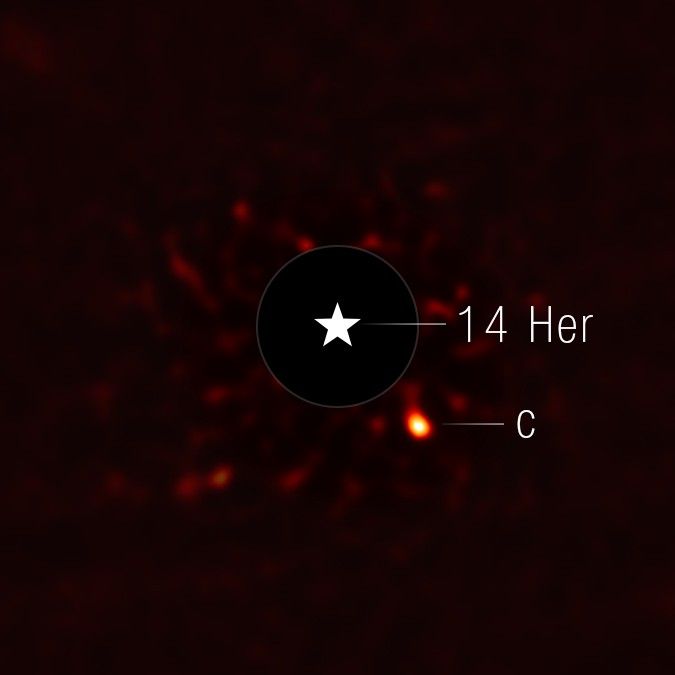- Get link
- X
- Other Apps
- Get link
- X
- Other Apps

Heading: Frigid Exoplanet in Strange Orbit Imaged by NASA’s Webb
In a significant breakthrough for exoplanet research, NASA’s James Webb Space Telescope has provided an unprecedented look at a planetary system described as abnormal and chaotic. Using Webb’s Near-Infrared Camera (NIRCam), researchers have successfully imaged the exoplanet 14 Herculis c, one of two known planets orbiting the star 14 Herculis, located approximately 60 light-years away in our Milky Way galaxy.
A Cold Discovery in the Cosmos
The exoplanet 14 Herculis c stands out as one of the coldest exoplanets ever directly imaged. While nearly 6,000 exoplanets have been discovered, only a fraction have been directly imaged, and most of those are extremely hot. The new data reveals that 14 Herculis c, which has about seven times the mass of Jupiter, is a frigid 26 degrees Fahrenheit (minus 3 degrees Celsius).
William Balmer, co-first author of the research paper and graduate student at Johns Hopkins University, highlighted the significance of this achievement: “The colder an exoplanet, the harder it is to image, so this is a totally new regime of study that Webb has unlocked with its extreme sensitivity in the infrared. We are now able to add to the catalog of not just hot, young exoplanets imaged, but older exoplanets that are far colder than we’ve directly seen before Webb.”
Image Details: 14 Herculis c (NIRCam). This image of exoplanet 14 Herculis c was taken by NASA’s James Webb Space Telescope’s NIRCam. A star symbol marks the location of the host star 14 Herculis, whose light has been blocked by a coronagraph on NIRCam.
A Peculiar Planetary System
The Webb’s image offers crucial insights into a planetary system unlike any other studied in detail. Key characteristics include:
- Sun-like Star: The central star, 14 Herculis, is similar to our Sun in age and temperature, albeit slightly less massive and cooler.
- Misaligned Orbits: Unlike our solar system, the planets in this system do not orbit on the same plane. Their orbits cross each other like an 'X', with an inclination angle of approximately 40 degrees.
- Planetary Interactions: The planets exert gravitational forces on each other as they orbit the star, creating a dynamically complex environment.
This marks the first time an image has been captured of an exoplanet in such a significantly misaligned system.
Theories Behind the Chaos
Scientists are exploring various theories to explain the unusual arrangement of planets in the 14 Herculis system. One leading hypothesis suggests that the planets scattered after a third planet was violently ejected from the system early in its formation.
Balmer further elaborated, “The early evolution of our own solar system was dominated by the movement and pull of our own gas giants. They threw around asteroids and rearranged other planets. Here, we are seeing the aftermath of a more violent planetary crime scene. It reminds us that something similar could have happened to our own solar system, and that the outcomes for small planets like Earth are often dictated by much larger forces.”
Webb Unveiling Planetary Secrets
The new data from Webb is providing researchers with unprecedented details about 14 Herculis c, including:
- Orbit Details: The planet orbits approximately 1.4 billion miles from the host star in a highly elliptical orbit, placing it roughly between Saturn and Uranus in our solar system.
- Atmospheric Dynamics: Measurements of the planet's brightness at 4.4 microns, combined with its known mass and the system's age, suggest complex atmospheric dynamics.
Daniella C. Bardalez Gagliuffi of Amherst College, co-first author of the paper, explained a surprising find: "This exoplanet is so cold, the best comparisons we have that are well-studied are the coldest brown dwarfs. In those objects, like with 14 Herculis c, we see carbon dioxide and carbon monoxide existing at temperatures where we should see methane. This is explained by churning in the atmosphere. Molecules made at warmer temperatures in the lower atmosphere are brought to the cold, upper atmosphere very quickly.”
Future Explorations
Researchers are optimistic that this initial image of 14 Herculis c is just the beginning. Future spectroscopic studies promise to further refine our understanding of the planet's atmospheric properties and the dynamics of this intriguing system.
The James Webb Space Telescope continues to revolutionize our understanding of the cosmos, offering unprecedented insights into exoplanets and the universe at large. This image of 14 Herculis c opens a new chapter in exoplanet research, demonstrating Webb's unique capabilities to explore the coldest and most distant worlds.
Tags: James Webb, Exoplanet, 14 Herculis c, NIRCam, Space Telescope, Cold Exoplanet, NASA, Milky Way, Astronomy, Planet Imaging
Source: https://science.nasa.gov/universe/exoplanets/frigid-exoplanet-in-strange-orbit-imaged-by-nasas-webb/
14 Herculis c
astronomy
Cold Exoplanet
exoplanet
James Webb
Milky Way
NASA
NIRCam
Planet Imaging
Space Telescope
- Get link
- X
- Other Apps
Comments
Post a Comment